|
|

          |
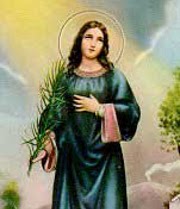 |
St. Agatha
Feastday: February 5
Patron Saint of: Breast Cancer, Bakers, Fire,
Jewelers, and Martyrs
Young, beautiful and rich, she lived a life
dedicated to God. She refused marriage proposals from all the
men who asked. The magistrate believed himself to be of high
enough rank to be worthy of her affection, but she refused him
also. When Decius announced the edicts against Christians, the
magistrate tried to profit by Agatha's sanctity. He planned to
blackmail her into sex in exchange for not charging her for
being a Christian. She still refused him. He then turned her
over to a brothel, but she refused to accept customers. After
rejecting Quintian's advances, she was beaten, imprisoned,
tortured, and her breasts were crushed and cut off. She had a
vision of St. Peter who then healed her wounds. Imprisoned
further, then rolled on live coals, she was near death when an
earthquake struck. She thanked God for an end to her pain and
died. |
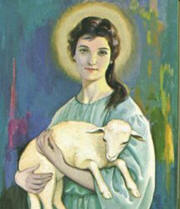 |
St. Agnes
Feastday: January 21
Patron Saint of: Engaged Couples, Young Women, and Chastity
St. Agnes was a Roman girl of only thirteen years when she
was martyred for her faith. Many young men wished to marry her,
but she told them that she had given her purity to God. When
Agnes refused the governor’s son, he accused her of being a
Christian. She was tied up in chains, but joy shone from her
face. She was sent to a place of sin, but an angel protected
her. At last, she was condemned to death.
|
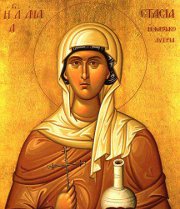 |
St. Anastasia
Feastday: October 28
Anastasia was a young Roman
woman of both noble and Christian birth who decided to enter a
convent. Her holiness earned her a great reputation. Valerian's
inquisitors broke into the convent and arrested her. She was
taken before the prefect general who threatened her with torture
if she did not renounce her faith. Anastasia chose torture. Her
face was then beaten bloody and she was sent back to prison. Her
joy made the prefect angrier. He had all of her limbs dislocated
and her sides burned by torches. This did not break her, so he
ordered her nails to be torn from her fingers, her teeth to be
broken with a hammer, and her breasts to be torn from her body.
Instead of dying in prison, her wounds were miraculously healed.
Eventually she was beheaded and buried outside of the city.
Source:
http://www.spreadjesus.org/st_anastasia-roman-martyr.html
|
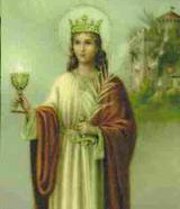 |
St. Barbara
Feastday: December 4
Patron Saint of: Prisoners, Miners,
Artillerymen, Danger from thunderstorms, and Sudden death
St. Barbara
was a beautiful and intelligent woman who was imprisoned in a
tower by her father, Dioscorus, to preserve her from the outside
world. While there, her studies led her to Christianity and she
converted to the faith. Her father then denounced her to the
authorities. He was ordered to torture and behead her. On his
way home, he was struck by lightning and died instantly.
Sources:
http://www.copticchurch.net/topics/synexarion/barbara.html
http://www.catholic-forum.com/saints/golden308.htm
http://saintbarbara.us/
|
 |
St. Bibiana
Feastday: December 2
Patron Saint of: Mental Illnesses and
Hangovers
St. Bibiana
was a Roman martyr. Her parents, Flavian and Dfarosa, were also
devout Christians who were persecuted and killed for their faith
by Emperor Julian. She and her sister, Demetria, were stripped
of all their possessions, but remained in their house to fast
and pray for five months. They were then brought before the
governor, whereupon Demetria died and Bibiana was handed over to
a woman who tried to tempt Bibiana to be unfaithful to God. With
His help though, she remained pure. Bibiana was scourged to
death with whips of lead.
Sources:
http://dimeliora.wordpress.com/2010/12/02/st-bibiana-virgin-and-martyr/
http://www.catholicculture.org/culture/liturgicalyear/calendar/day.cfm?date=2009-12-02
http://www.sspx.ca/EucharisticCrusade/2001December/St_Bibiana.htm
http://catholicharboroffaithandmorals.com/St.%20Bibiana.html
|
 |
St. Catherine of Alexandria
Feastday: November 25
Patron Saint of: Students, Teachers,
Librarians, and Lawyers
St. Catherine was born in Alexandria to a noble
family. She was well educated and also a very good speaker. She
had a vision that converted her to Christianity as well as
denounced the rule of Maxentius who at the time persecuted
Christians. She began to then preach and debate against pagan
philosophers whom she later converted. She also converted 200
soldiers and also Maxentius' wife. Enraged, he arrested St.
Catherine and sentenced her to death by a spiked wheel. When she
touched the wheel it then shattered. Maxentius then decided to
behead her. She was martyred for her preaching of Christianity.
Sources:
http://www.catholic.org/saints/saint.php?saint_id=341&wf=rsscol
http://www.americancatholic.org/Features/Saints/saint.aspx?id=1616
|
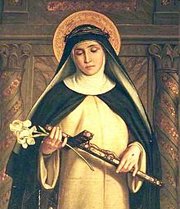 |
St. Catherine of Siena
Feastday: April 29
Patron Saint of: Nurses, Temptation,
Miscarriages, Sick, and Firefighters
St. Catherine was born the 25th out of 26
children on March 25, 1347. She practiced austerities at a very
young age, would spend long amounts of time in prayer, and had
mystical visions; she also consecrated her virginity to Christ
at the age of 7. Although her parents wanted her to marry, her
father, after much persistence from Catherine, eventually
relented and she joined the Third Order of Dominicans. During
her spiritual espousal she had a vision of the baby Jesus
offering her a wedding band. She took this as another sign that
she had dedicated her life to the right cause. She spent most of
her time helping the poor, sick, and the injured. After a while,
she began to gather disciples. She achieved spiritual greatness
throughout her life here on Earth. It was chiefly by her advice,
letters, and persistence that convinced St. Gregory XI to leave
Avignon and head back to Rome, and she also wrote Dialogue
(a conversation between the Eternal Father and the human
soul). Because of her book and spiritual guidance that she
offered, she was named a Doctor of the Church. She died on the
29th of April, 1380, and the age of 33. |
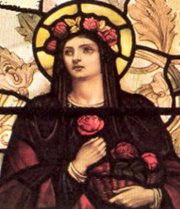 |
St. Dorothy
Feastday: February 6
Patron Saint of: Brides, Florists, and
Gardeners
St. Dorothy was born in Cappadocia, in Asia Minor
(now in the region referred to as Turkey). Her name means “Gift
of God” and it is said that her parents were martyred years
before St. Dorothy was. She lived during a time of persecution
in the Catholic Church. When she refused to participate in the
pagan sacrifices during Emperor Diocletian’s persecution, she
was tortured and ordered to be executed. It is said that she is
responsible for the conversion of the martyr, Theophilus. As the
story goes, while she was on her way to her execution, she met
the young lawyer. He mocked her, asking her to bring him fruits
from “the garden.” When she knelt for her execution, she prayed,
and her angle appeared carrying a basket full of three roses and
three apples appeared and delivered them to Theophilus, who then
converted.
|
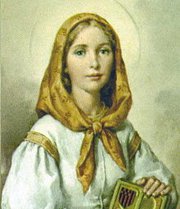 |
St. Dymphna
Feastday: May 15
Patron Saint of: Mental and Nervous Disorders
St. Dymphna was born the only daughter to a pagan
king and very beautiful mother. She lost her mother when she was
only 14, and her father became so depressed that he was
afflicted by mental illness. Overcome by grief, he sent
messengers to town and other lands to find a woman of noble
birth that resembled his late wife. When no such woman could be
found, his evil advisor recommended that he marry his daughter
instead. Dymphna fled from him with her confessor St. Gereban
and two other friends. The king found them in Belgium and
immediately cut off the head of St. Gereban. He begged her to
return with him and be his wife, but when she stayed true to her
God and to her vow of virginity, he beheaded her. She was only
15 when she died and she received a crown of martyrdom for her
defense of her purity in 620. There was a church built in her
name in Gheel, Belgium where her body is preserved in a silver
reliquary.
|
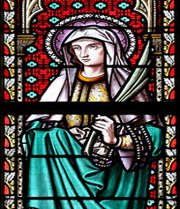 |
St. Emerentiana
Feastday: January 23
Patron Saint of: Stomach Aches
St.
Emerentiana was the daughter of St. Agnes’s nanny. A few days
after the death of St. Agnes, she was caught praying next to her
tomb. She told the angry mob of pagans that she was a Christian
as well and the foster sister of St. Agnes. She was then stoned
to death by the crowd.
Sources:
http://aesaintsoftheday.blogspot.com/2010/01/st-emerentiana.html
http://liturgialatina.blogspot.com/2011/01/23rd-january-st-emerentiana-virgin-and.html
|
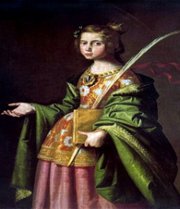 |
St. Eulalia
Feastday: December 10
Patron Saint of: Widows, Runaways, Victims of
Torture, and Patroness of Merida, Spain
St. Eulalia descended from one
of the most prominent families in Spain and was educated in the
Christian religion. When she was just twelve years old, the
Roman Emperor Diocletian ordered that all people must offer
sacrifices to the gods. She appeared before the court and
reproached him for destroying souls by making them renounce the
true God. At first, the judge was amused and tried to flatter
her, but she would not deny God. He ordered that her body be
torn by iron hooks. She was also set on fire and eventually died
from the smoke and flame.
Sources:
http://www.catholicnewsagency.com/saint.php?n=79
http://www.catholic-forum.com/saints/ste06001.htm
http://www.catholic-saints.info/roman-catholic-saints-a-g/saint-eulalia.htm
http://www.catholicireland.net/saintoftheday/st-eulalia-of-merida-d-304-virgin-martyr/
http://www.loyolapress.com/saints-stories-for-kids.htm?cId=403382 |
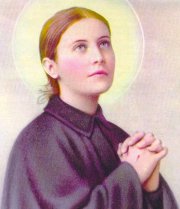 |
St. Gemma Galgani
Feastday: April 11
Patron Saint of: Pharmacists, those who have
lost parents, back pain, and migraines
St. Gemma Galgani was born on March 12th,
1878 in a small Italian town outside of Lucca. At a very young
age, she developed a great love for prayer. She was quiet and
reserved, but she was always kind and very happy towards others.
She had chronic ill health that would prevent her later from
joining the convent as well as continuing her education.
Throughout her life, she was gifted with mystic experiences and
special graces form God. When she developed a serious case of
meningitis, she prayed to (later canonized) Gabriel Possenti,
and through his intercession she was healed. Later in life, she
was gifted with the grace of stigmata. It appeared on her body
every Thursday until the last three years of her life. She was
also granted to grace of often seeing her guardian angel, whom
she would send on errands, most often to deliver a letter to her
confessor in Rome. St. Gemma Galgani died of tuberculosis on
April 11th, at the age of 25. She was beatified in
1933 and canonized on May 2nd, 1940, only 37 years
after her death.
|
 |
St. Joan of Arc
Feastday: May 30
Patron Saint of: France
St. Joan of Arc was born on January 6th, 1412 to pious peasant
parents in Domremy, France. She heard the voices of St. Michael,
St. Catherine, and St. Margaret at a young age and throughout
her lifetime. In May 1428 they told Joan to go to the King of
France and help him to reconquer his kingdom from the King of
England. When she was 17, she was given a small army and she
raised the siege on Orleans on May 8th, 1429. Because of her
victories, King Charles was able to enter Rheims and be crowned
at her side. In May of 1430 she was captured and sold to the
English when King Charles and the French did nothing to save
her. She was tried for war crimes in Rouen and was trapped into
making damaging statement. She was condemned to death as a
heretic, a sorceress, and adulteress and was burned at the stake
on May 30th, 1431 at the age of 19. 30 years later she was
exonerated of Guilt and canonized by Pope Benedict XV.
|
 |
St. Kateri Tekakwitha
Feastday: July 14
Patron Saint of: Ecology, Exiles, Loss of
Parents, people ridiculed for their piety, and World Youth Day
Blessed Kateri Tekawitha is the patron saint of
the environment and ecology. She was born near the town of
Auriesville, New York, in 1656. She was the daughter of a Mohawk
warrior and was only four years old when her mother died of
smallpox. The disease also attacked Kateri and transfigured her
face. After her mother’s death, she went to live with her two
aunts and her uncle, where she was converted in her teens. When
she was baptized at the age of twenty, it greatly angered her
tribe, and although she suffered for her faith she was firm in
it. She was devoted to the Eucharist and to Jesus Crucified. She
died on April 17, 1680 at the age of twenty-four. She is known
as the “Lily of the Mohawks” and devotion to Kateri is
responsible for establishing Native American Ministries in
Catholic Churches’ all over the U.S. and Canada. She is the
first Native American saint.
|
 |
St. Leocadia
Feastday: December 9
Patron Saint of: Toledo, Spain
St. Leocadia was a native of
Toledo, Spain, and was apprehended by order of Dacian, a cruel
governor under the rule of Emperor Diocletian in 304. Hearing of
the martyrdom of St. Eulalia, she prayed that God would not
prolong her exile, but unite her speedily with her holy friend
in His glory. Her prayer was heard, and she happily expired in
prison. Three famous churches in Toledo bear her name, and she
is honored as principal patroness of that city.
Sources:
http://magnificat.ca/cal/en/saints/saint_leocadia_of_toledo.html
|
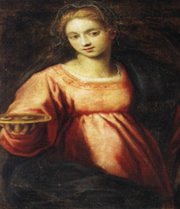 |
St. Lucy
Feastday: December 13
Patron Saint of: Blind People
At a very young age, St. Lucy
dedicated herself to Christ, but her mother had other plans for
her. She was soon betrothed to a young pagan man. To change her
mother's mind, she began to pray at the tomb of St. Agnes. Her
mother's long illness was then miraculously cured. The rejected
bridegroom denounced Lucy as a Christian to the governor. When
the guards came to force her into prostitution, they could not
move her. She was then tortured and killed.
Sources:
http://www.ewtn.com/library/mary/stlucy.htm
http://www.catholic-saints.info/patron-saints/saint-lucy.htm
http://www.aquinasandmore.com/catholic-articles/st.-lucy/article/215/sort/relevance/productsperpage/12/layout/grid/currentpage/1/keywords/st.%20lucy,%20saint%20lucy |
 |
St. Macrina the Younger
Feastday: July 19
Patron Saint of: Widows
St.
Macrina (330-380) was the eldest child in a family of saints.
Her grandparents were martyrs. Her parents, Basil and Emmelia,
are also recognized as saints. She was well educated by her
mother and was able to read at an early age. Macrina, in turn,
became the teacher of her younger brothers
Basil, later bishop of Neocaesarea, and
Gregory, later bishop of Nyssa, who themselves became two of
the greatest teachers in the Universal Church. At age 12,
Macrina was engaged to be married, but when her fiancÚ died
quite suddenly, she decided she would not marry despite
subsequent offers. Instead, she dedicated her life to raising
her brothers and assisting her mother with housework, cooking,
and directing the servants. She also devoted a good part of her
time to prayer. After her siblings had grown up, they called her
Macrina the Great, as they had in their childhood, a sign of the
high respect they had for her. On the death of their father,
Basil took her, with their mother, to a family estate in Pontus.
Here, with their servants and other companions, they consecrated
themselves to God and led a contemplative life. Macrena
succeeded her mother in becoming the head of the double
monastery of women and men founded by Basil. Kissing an iron
crucifix that held the relics of the Cross of the Savior, which
she always had close to her, St. Macrina died peacefully in the
year 379. She was buried beside her parents. |
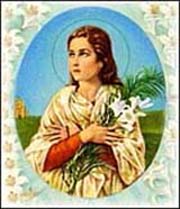 |
St. Maria Goretti
Feastday: July 6
Patron Saint of: Young Women, Purity, and
Victims of Rape
Maria Goretti was born October
16, 1890 in Corinaldo Italy to Luigi Goretti and his wife
Assunta Carlini. Baptized on October 17 in the the Church of San
Francesco. October 4, 1896 Maria was confirmed. June 16, 1901
Maria receives her First Holy Communion. Maria lived her young
life as a devoted Catholic until July 5, 1902 when she was
attacked by her neighbor with intent to sexually abuse her. July
6, 1902 Maria then dies at the age of 11 after she forgives her
neighbor. She eventually became known to be the youngest Roman
Catholic saint ever.
http://www.mariagoretti.org/mariabio.htm
http://www.catholic.org/saints/saint.php?saint_id=78
Biography
|
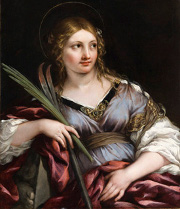 |
St. Martina
Feastday: January 30
St. Martina, a noble virgin of
Rome, was the daughter of a Consul. Having lost her parents as a
child, and being exceedingly fervent in the practice of the
Christian religion, she was singularly charitable to the poor,
and distributed among them her immense riches. During the reign
of Alexander Severus, she was ordered to worship the false gods,
but courageously refused to commit so detestable a crime. Where
upon she was several times scourged. Her flesh was torn with
iron hooks and nails, and with potsherds, and her whole body was
cut with sharp sword. She was scalded with boiling oil, and was
at length condemned to be devoured by wild beasts in the
amphitheatre, but being miraculously left untouched by them, she
was thrown on a burning pile, from which she also escaped
unhurt, by the same divine power. She was then beheaded.
Source:
http://www.catholicculture.org/culture/liturgicalyear/activities/view.cfm?id=1008
|
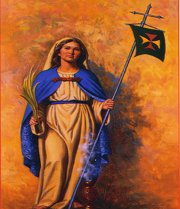 |
St. Odilia
Feastday: December 13
Patron Saint of: Blind and Partially Sighted
People
In the year 300, St. Odilia
and ten other virgins set out from England on a pilgrimage to
spread the faith in the East. Their ship, by accident, changed
course and they ended up being captured and taken by barbarians
to Cologne. There the women were tempted to give into the
barbarians and give up their sacred purity. The women then
replied to the barbarians, "I have chosen the cross," and the
barbarians killed them. St. Odilia eventually became patron
saint of the Order of the Holy Cross.
Sources:
http://www.catholic.org/saints/saint.php?saint_id=155 |
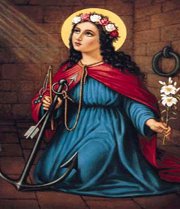 |
St. Philomena
Feastday: August 11
Patron Saint of: Babies and Youth
St. Philomena was born in 291
and died in 304. Very little is known about St. Philomena other
than she was a martyr. Her remains were discovered in 1802 in
the Catacombs of Priscilla. After people would see her remains,
many miracles occurred such as cured ailments and healed wounds.
In 1833 a Neapolitan nun reported a vision which revealed that
St. Philomena was a Greek princess martyred for her devotion to
God at age 13 by Diocletian, the Roman Emperor from 284 to 305.
She eventually became a saint and her remains are still on
display in the Church of Our Lady of Grace in Mugnano del
Cardinale.
Source:
http://www.catholic.org/saints/saint.php?saint_id=98 |
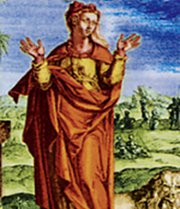 |
St. Prisca
Feastday: January 18
Patron Saint of: Good Marriages
St. Prisca was born to
Christian parents of a noble family. She was raised during the
reign of Roman Emperor Claudius. Prisca's parents went to great
lengths to conceal their faith. St. Prisca, however, did not
feel the need to take precautions. The young girl openly
professed her dedication to Christ, and eventually, she was
reported to the emperor. Claudius had her arrested, and
commanded that she make sacrifice to idols. St. Prisca refused,
and was tortured. Claudius ordered that she be imprisoned, in
the hopes that she would denounce Christ. When all efforts to
change her mind failed, she was taken to face a ferocious lion
in the coliseum, but the lion began to gently lick her feet. She
was then beheaded.
Sources:
http://romanchurches.wikia.com/wiki/Santa_Prisca |
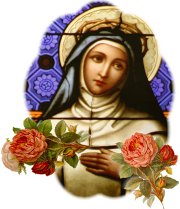 |
St. Rose of Lima
Feastday: August 23
Patron Saint of: Latin America and the
Philippines
St. Rose of Lima was born in
Lima, Peru on April 20, 1586. Her real name was Isabel, but she
was such a beautiful baby that she was called Rose. As she grew
older, she became more beautiful everyday. Her mother decided to
put a wreath of roses on her head to show off her beauty. Rose
did not approve though. She wanted to devote her life to Jesus.
So she made herself unappealing to others by adding thorns to
her wreath which pierce her head. She also rubbed peppers on her
face to blister her kin. Her loneliness pained her very much but
she offered her pains to God and kept her devotion to Him till
her death.
Sources:
http://www.catholic.org/saints/saint.php?saint_id=446
http://www.britannica.com/EBchecked/topic/509805/Saint-Rose-of-Lima
|
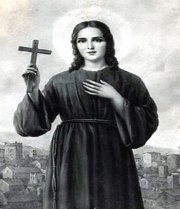 |
St. Rose of Viterbo
Feastday: September 4
Patron Saint of: People in Exile
Saint Rose of Viterbo was born
in 1235 in Viterbo, Italy. During her time, Emperor Frederick
conquered many lands that belonged to the Church. She found it
her mission to preach to her city and nearby cities to remain
faithful to God and to not let the Emperor take away their faith
or their land. Eventually the Emperor exiled her from Viterbo to
get her to stop preaching against him. Rose knew the Emperor
would die soon and he did. Rose returned to Viterbo to continue
preaching the word of God. She died in 1252 at the age of 17.
Her body is preserved today in Viterbo, Italy.
Sources:
http://holyspiritinteractive.net/kids/saints/0904_roseviterbo.asp
|
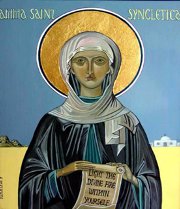 |
St. Syncletica
Feastday: January 5
St. Syncletica was born to a
prominent family in Alexandria in the fourth century. She was
very beautiful and dedicated herself to God, refusing to marry
anyone. After the death of her parents, she distributed her
inheritance to the poor. She left the city together with her
younger sister, and lived in a crypt for the rest of her life.
Sources:
http://www.catholic.org/saints/saint.php?saint_id=813
https://oca.org/FeastSaintsViewer.asp?SID=4&ID=1&FSID=100099
|
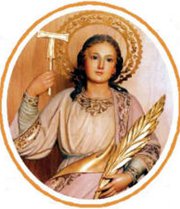 |
St. Thecla
Feastday: September 23
Patron Saint of: Tarragona, Spain
Thecla was a native of Iconium
who was so impressed by the preaching of St. Paul on virginity
that she broke off her engagement to live a life of virginity.
Paul was ordered to be scourged and banished from the city for
his teaching, and Thecla was ordered to be burned to death. When
a storm extinguished the flames, she escaped with Paul and went
with him to Antioch. After preaching with Paul, she was
condemned to be eaten by wild bests in an arena. When the beasts
did no harm to her, she rejoined Paul in Lycia and was told by
him to preach the Gospel. She lived as a hermitess for the next
seventy-two years and died in Lycia.
Sources:
http://www.catholic.org/saints/saint.php?saint_id=323 |
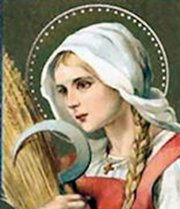 |
St. Zita
Feastday: April 27
Patron Saint of: Domestic Workers
St. Zita was born to a very
poor but holy Christian family. Her sister was a Cistercian nun
and her uncle became a hermit that many of the locals regarded
as a saint. At the age of twelve, Zita became a housekeeper for
a rich family in Lucca. She stayed with this family for the last
48 years of her life. Although busy, she found time to go to
Mass daily, recite prayers, and do her chores so perfectly the
other servants were jealous of her. She quickly became a good
friend to the family and they were never upset by her generous
gifts of food to the poor. She visited the sick and imprisoned
whenever her work allowed and at her death in 1278 the people
declared her a saint. |
| |

![]()